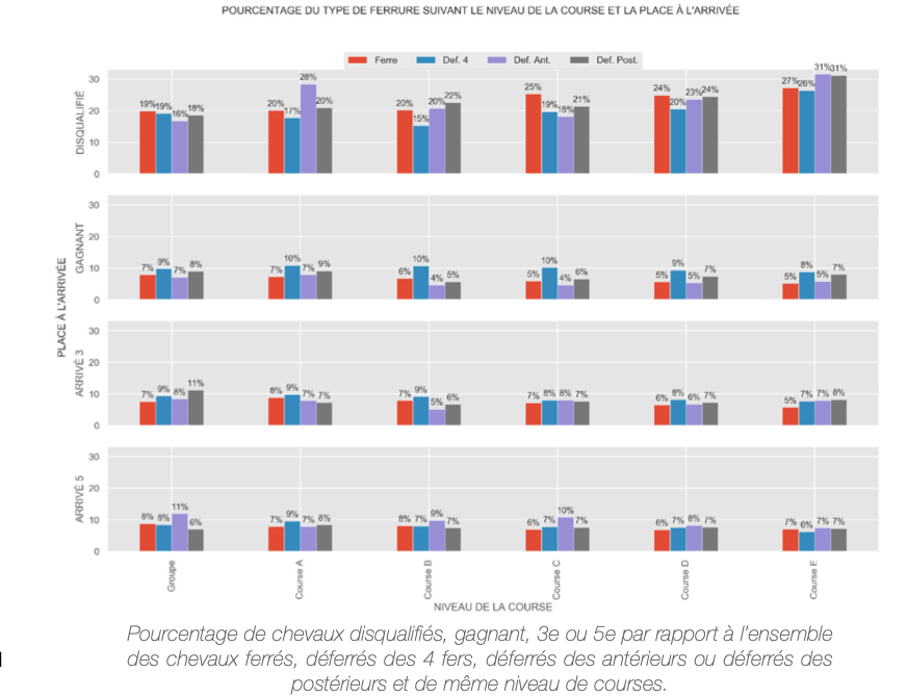At the races, when it comes to weight, everything counts. From the rider’s equipment to the one of his horse, the horse’s team tries to reduce the weight carried by the horse as much as possible in the hope of limiting its energy expenditure and therefore improving its speed.
What does science say about it? What is the impact of weight on the horse’s speed?
To study these questions we will make a distinction between harness racing and flat racing, for which different reasoning apply.
When trotting, the question of weight is particularly relevant to the shoeing, which we’ll be looking at. For thoroughbreds, as running without shoes is forbidden, this issue will be studied along with the handicaps and the impact of the weight added to the horse.
The impact of shoeing on the trotter’s speed
Unlike flat trainers in France, harness trainers can choose to have their horses run without shoes, or barefoot.
For flat racing, it is forbidden in France to run barefoot for two-year-olds, then it is more a question of permanent unshoeing for horses that are not comfortably shod, rather than a strategy to gain speed. Regulations vary from country to country.
Within trotters, this technique is a real strategy and consists in removing the horse’s shoes just before the race after a meticulous preparation of the horse’s foot. The schedule has to be carefully followed in order to find a good balance between speed optimisation and the fact that he has shoes or not.
A trotter is considered to be shod when “at least half of its hoof is fitted with a rigid and visible protection which ensures this function throughout the race (with the exception of the resin)”. On the contrary, a horse is said to be barefoot “when its hoof is unprotected or protected only by resin”.
What are the factors that explain why removing the horse’s shoes implies an improvement in speed?
Lightness
More natural gait
A horse who is barefoot logically carries less weight, which allows it to improve its speed. Admittedly, it is only about 800 grams gained (about 200 grams per shoe), which is derisory compared to the weight of the horse, but placed at the end of the limb, this weight makes the stride heavier and affects locomotion.
Without the addition of any artifice at the end of the horse’s limb, the trotter’s gaits are more natural, which makes it easier for the driver to cause fewer gait irregularities.
Irrigation and oxygenation of the foot
The anatomy and physiology of the horse’s foot is complex. When the foot carries the horse’s body by touching the ground, the special anatomy of the hoof provides the horse with a vital cushion for the quality of the stride. The heels spread apart, the fork stretches, which helps to cushion but also compress the blood vessels, increasing the blood pressure in the hoof, which pushes the blood towards the heart. When the foot touches the ground, the foot fills itself again with blood. When the horse is shod, hoof spacing and fork crushing are less important since they are held by the shoe. Thus, the removal of shoes allows a blood pumping system that allows a good oxygenation of the blood and an optimal perfusion of the tissues.
The efficiency of this “suction – delivery” pump depends on the horse (tolerance to the removal of the shoe, condition of the foot and horn), on its type of shoe (barefoot or not, as well as other types of protection such as resin), but also on the type of ground (hard or shock-absorbing) on which he is walking. However, the surface on which the horse runs can also have a detrimental effect on the foot in terms of wear and tear, the development of sensitivity and even deeper lesions, especially when it is very abrasive.
Example: Influence of shoeing on the place at the finish and the level of races at Vincennes in harness trotting
Our data science experts were able to verify these theories. Here are the conclusions they came to.
By a first check on numbers, shod horses are more likely to go offstride than horses shod at any level of racing. Furthermore, as the level of the race increases, the proportion of horses going offstride increases.
To win, the influence of the shoeing is greater for class races than for group races. Horses that are barefoot have a better chance of winning in class races. This difference is thinner for the 3rd place, however, the horses arriving 3rd are most often barefoot. The difference is even less marked for the 5th place, where there are almost as many shod and barefoot horses. Of course, this statistic can also be explained by the fact that trainers choose to race their horses when they think that their starters have a good chance: the horse is ready to win so we unshoe the horse to put all the chances on its side. Thus, it makes sense that statistically the winners are most often barefoot.
It is interesting to note that hindquarters have better results than forelegs, and in most cases than shod horses.
Thus, the issue of shoeing in trotting racehorses is relevant and important when developing the racing strategy because it can influence the horse’s speed positively or negatively. Monitoring closely the training speed data for a certain type of training, with and without shoes, can be extremely useful to determine the horse’s preferences. In the EQUIMETRE platform, each training can be edited to indicate the shoeing, the track, the track conditions, and the type of training, in order to compare smartly the trainings from one session to another.
Keywords: shoeing, speed, race horses, strategies



